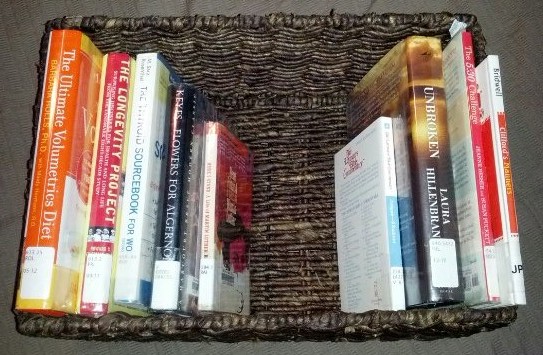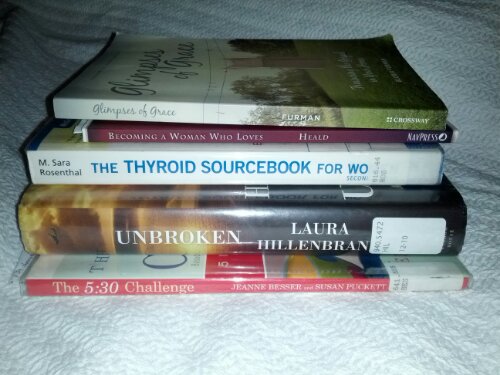I started the month strong on the blogging front, but quickly fell off that particular bandwagon. I am proud to announce, however, that I have NOT fallen off the reading wagon. I have enjoyed finishing several books over the past month.
This month, I read:
- No Impact Man by Colin Beaver
As a guilt-free (at least as far as environmental concerns go) conservative who nevertheless loves to avoid waste, I enjoyed “the adventures of guilty liberal who attempts to save the planet.” Beaver’s adventures in bread baking, cloth diapering, no packaging-shopping, light-turning-off, bicycle riding, and the like interested me to no end. Less interesting were “the discoveries he makes about himself and out way of life in the process.” See, Beaver is a Buddhist of sorts, who meditates regularly and quotes his feel-good Zen master over and over and over again ad nauseum. I’m going to guess that (of my regular readers) only the environmentally interested are going to be able to push through Beaver’s worldview to enjoy this book-so I won’t be at all surprised if the rest of you skip it. - Hope by Lori Copeland
Standard Christian fiction. Nothing extraordinary, but still entertaining. - Calvin Coolidge by David Greenberg
Daniel rather likes Coolidge, and I knew next to nothing about him, so I decided to read a biography. The biography the library offered is a part of Arthur Schlesinger, Jr.’s American Presidents series–and is written by someone who is clearly NOT a fan of Coolidge but who was trying to be fair. As such, this book was a rather dry and mostly measured account of Coolidge’s presidency. I’m glad I read it (since it gives me some background on the former president), but I wouldn’t really recommend it. - Good-bye Mr. Chips by James Hilton
I watched a film by the same name several years back, but don’t remember anything of the plot. Reading this book, I realize there isn’t any plot, per se. What this book is is a charming character sketch of an old-fashioned British schoolmaster who ended up making his mark on generations of British boys–but whose own influence was mostly due to the now forgotten Mrs. Chips, who turned him from a solid but unmemorable master to a thoughtful and quirky “institution”. I greatly enjoyed this little easy-to-read novel. - More Sex is Safer Sex: The Unconventional Wisdom of Economics by Steven E. Landsburg
I picked this book up because I like economics…and because the title really shocked me. Turned out, the “title chapter” (sort of a like a title song is only one of a diverse collection of songs, the title chapter is just one of the many explorations in this book) was just as shocking as the title was. Long story short, Landsburg argues that moderate levels of promiscuity would slow the spread of STDs like AIDS because it would increase the pool of uninfected individuals, making it easier to have sex without putting yourself at risk. While I have my doubts about his economic argument, I have far more doubts about the prudence of his advice based on both morals (when God says something’s sin, it’s best not to do it) and because I don’t think he takes into account the potential other effects of individuals trading abstinence or monogamy for promiscuity. But…the important thing was that it made me think. The whole book did. Often, my conclusions differed from Landsburg’s based on externalities I felt he didn’t appropriately address or based on assumptions he made (that I felt were incorrect) about what is good or what government is for, etc. But it was a very interesting book to think my way through. I am glad I read it. - Mesopotamia and the Fertile Crescent: 10,000 to 539 BC by John Malam
A very nice children’s history of Mesopotamia. I noticed one Biblical error (stating that Nebuchadrezzar II’s ziggurat in Babylon was the Biblical “tower of Babel”, despite it being contemporary with the fall of Jerusalem rather than with the pre-patriarchal period), but in general, this is a well-written history of the early residents of the world’s oldest inhabited region. - The Blue Castle by L.M. Montgomery
I read this for the L.M. Montgomery Challenge and Reading to Know Classic Book Club–and I’ll be writing up my full review sometime soon. Suffice to say that I enjoyed this book. I identified strongly and not at all with the main character–an almost-old-maid (that was me) who lived her entire life trying to make other people happy (that was not me) who stops caring what anyone thinks (that would be me) and becomes a… but I can’t tell you what she becomes, because that would be giving it away, right?

Books in Progress:
- Rose Under Fire by Elizabeth Wein
Because I am determined to sneak at least one book in for the Armchair Cybils. And because Amy’s review convinced me that it was well worth the read. - Laura Ingalls Wilder: A Biography by William Anderson
Because I’m participating in Barbara’s Laura Ingalls Wilder Reading Challenge and wanted a biography of Laura that I hadn’t read yet. - One Thousand Gifts by Ann Voskamp
Because everyone was talking about it when it first came out, and now it’s no longer in the “new books” section at the library, so I get to keep it for longer than two weeks. - The 1920s edited by John F. Wukovits
Because I wanted more context for Calvin Coolidge. - Discover your Inner Economist by Tyler Cowen
Because I like economics and might as well read Dewey Decimal 330.(I do have a decent start.) - No More Sleepless Nights by Peter Hauri and Shirley Linde
Because I’m not sleeping that well these days. - To-Do List by Sasha Cagen
Because I love lists, and I like the idea of snooping through other peoples’ lists. - Sumer and the Sumerians by Harriet Crawford
Because I’m researching for the children’s narrative history of the world I’m going to write someday (and have my sister-in-law illustrate) so that I can teach my children someday using it. (Duh!)
And, of course, there are plenty more in the wings for when I feel the need for some new material!


The Rest I have from the Library
Don’t forget to drop by 5 Minutes 4 Books to see what others are reading this month!



